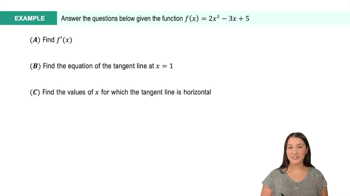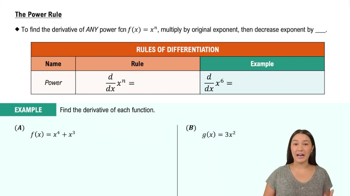Table of contents
- 0. Functions7h 52m
- Introduction to Functions16m
- Piecewise Functions10m
- Properties of Functions9m
- Common Functions1h 8m
- Transformations5m
- Combining Functions27m
- Exponent rules32m
- Exponential Functions28m
- Logarithmic Functions24m
- Properties of Logarithms34m
- Exponential & Logarithmic Equations35m
- Introduction to Trigonometric Functions38m
- Graphs of Trigonometric Functions44m
- Trigonometric Identities47m
- Inverse Trigonometric Functions48m
- 1. Limits and Continuity2h 2m
- 2. Intro to Derivatives1h 33m
- 3. Techniques of Differentiation3h 18m
- 4. Applications of Derivatives2h 38m
- 5. Graphical Applications of Derivatives6h 2m
- 6. Derivatives of Inverse, Exponential, & Logarithmic Functions2h 37m
- 7. Antiderivatives & Indefinite Integrals1h 26m
- 8. Definite Integrals3h 25m
3. Techniques of Differentiation
Basic Rules of Differentiation
Problem 3.9.5
Textbook Question
State the derivative rule for the logarithmic function f(x)=log(subscript b)x. How does it differ from the derivative formula for ln x?
 Verified step by step guidance
Verified step by step guidance1
Recall that the derivative of the logarithmic function f(x) = log_b(x) can be expressed using the change of base formula: log_b(x) = ln(x) / ln(b).
Differentiate f(x) = log_b(x) using the quotient rule, which states that if you have a function h(x) = u(x)/v(x), then h'(x) = (u'v - uv')/v^2.
In this case, let u(x) = ln(x) and v(x) = ln(b). The derivative of u(x) is u'(x) = 1/x, and since v(x) = ln(b) is a constant, v'(x) = 0.
Substituting these derivatives into the quotient rule gives f'(x) = (1/x * ln(b) - ln(x) * 0) / (ln(b))^2 = 1 / (x * ln(b)).
In contrast, the derivative of ln(x) is simply 1/x, which shows that the presence of the base b in log_b(x) introduces the factor of 1/ln(b) in the derivative.
Recommended similar problem, with video answer:
 Verified Solution
Verified SolutionThis video solution was recommended by our tutors as helpful for the problem above
Video duration:
1mPlay a video:
Was this helpful?

 3:59m
3:59mWatch next
Master Derivatives of Linear Functions with a bite sized video explanation from Callie
Start learningRelated Videos
Related Practice







